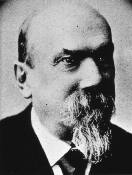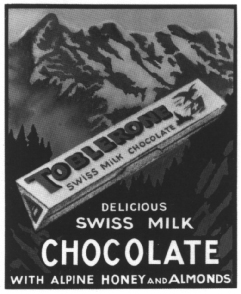 |
Toblerone"Swiss confectioner moulds a mixture of nougat and milk chocolate in the shape of the Matterhorn " |
JOHANN JACOB TOBLER (1930-1905)
 The decisive moment took place in 1908 in Bern (Switzerland). Emil Baumann
had returned from his trip to France and as a present for his boss, the
Swiss confectioner Theodor Tobler, he had brought some pieces of Montélimar-nougat.
That same evening the two men started experimenting in Mrs Tobler kitchen.
They combined nougat ingredients (almonds, honey and sugar) with milk
chocolate. The final result was such a success that Tobler had to take
out a patent so that it could not be copied.
The decisive moment took place in 1908 in Bern (Switzerland). Emil Baumann
had returned from his trip to France and as a present for his boss, the
Swiss confectioner Theodor Tobler, he had brought some pieces of Montélimar-nougat.
That same evening the two men started experimenting in Mrs Tobler kitchen.
They combined nougat ingredients (almonds, honey and sugar) with milk
chocolate. The final result was such a success that Tobler had to take
out a patent so that it could not be copied.
Nowadays two shifts of Tobler staff produce 135 tons of it every day in the Bern plant. If you line up the 100 gram bars, you would have 283 kilometers of it. Every one knows Toblerone, including those who do not buy the product: triangular bars of Swiss chocolate, wrapped in cream-coloured cardboard boxes. In what atmosphere was this remarkable product produced?
Father Johan Jacob Tobler was born in a little town called Wiehnacht-Tobel in the canton of Appenzell. In 1868, after seventeen years of French and German 'Wanderjahre' he started a confectionery in Bern. Business went well for the 'Confiserie Spéciale', which made him move to a bigger building in the Längass-Strasse ten years later. At the end of the century, the demand for his chocolate, prepared according to traditional methods, had risen the point that Jacob , with the aid of his son Theodor, built a little factory. In 1900, at the age of 70, he transferred it to his three children - Theodor, Emil and Martha. However it was Theodor who mostly determined the future of the company.
Around 1902 the company employed fifty people and it had raised one million Swiss francs by issuing stock for the first time. This enabled it to invest in the latest and best production techniques so that it could ensure its growth.
Einstein
According to the Tobler company, Theodor was really looking for a new item to broaden the range of his product. Therefore he had sent his production manager Bauman to Metz, to get the company secrets of a friend who owned a confectionery there. It is not clear whether Bauman had brought along the nougat in order to copy it, mix it with chocolate or as a regular souvenir. However Theodor was truly aware that he had found something worthwhile. On the 29th of March 1909 he became the first and (up to now) last man in the Swiss history to take out a patent on 'a procedure to produce a new kind of chocolate'.
At that time, the small patent agency in Bern employed no other than Albert Einstein himself. The people at Tobler like to think that it could have been one of the most famous scientists of the twentieth century, who approved this patent. On the patent is says: 'The subject of the hereby described invention is a procedure to produce a new kind of chocolate in which a mixture of boiled fruit, honey, glucose, sugar and egg white is added to the chocolate pulp. The fruit ingredients can be almonds or hazelnuts. The procedure can be executed as follows: first the almonds are mixed with honey, glucosis and sugar after which everything is boiled. The egg whites are beaten into a spongy foam and added to the boiling mass. The boiling lasts until all of the water inside the rough almonds has been evaporised. Next, one rolls up the mixture, lets it cool down and flattens it. The quantity of the mixture determines the amount of chocolate mass to add, just before the mixture starts to harden..'
Insiders say that the patent does not even mention a whole range of specific production secrets. Two of which have been revealed in the Swiss media by a former production manager. Toblerone does not use regular honey, instead they import Mexican honey from the forest because it maintains its taste better when heated to a high degree. Further more the nougat is boiled in a copper kettle, because that heats the nougat faster than the modern metal recipients do. The speed of this heating process has got a great influence on the final quality.
Matterhorn
 A
lot of stories are told about the name Toblerone, on the shape of the
bar and the colour of the package. Theodor remembers the Italian range
of nougat products entitled 'Torrone'. He merged the family name 'Tobler'
with the nougat name 'Torrone' into the brand name 'Toblerone'. None of
the documents available in the company archieves mention the "one of a
kind" shape. It is safe to presume that Theodor tried to copy the Swiss
mountains, in particular the Matterhorn which symbolizes Switzerland.
A
lot of stories are told about the name Toblerone, on the shape of the
bar and the colour of the package. Theodor remembers the Italian range
of nougat products entitled 'Torrone'. He merged the family name 'Tobler'
with the nougat name 'Torrone' into the brand name 'Toblerone'. None of
the documents available in the company archieves mention the "one of a
kind" shape. It is safe to presume that Theodor tried to copy the Swiss
mountains, in particular the Matterhorn which symbolizes Switzerland.
This connection is above all suggested by the advertising posters which display the peaky bar in front of the mountain range. The edelweiss which was added to the logo, speaks for itself. Probably the practicality of the peaks, since they enable the customer to divide the bar into smaller, ready to serve pieces, was an important aspect as well. All in all it is obvious that the shape of the Toblerone bar, created a clear distinction from other chocolate products right from the start.
It is being said that Theodor Tobler was inspired by Paris, the city he preferred the most, when he chose the creamy coloured packaging with its red printing. He liked to visit the Folies Bergères where his favourite dancing group used to perform dressed in red and creamy costumes.
In 1970 the Tobler firm merged with Suchard, the big Swiss confection producer. Jacobs (coffee) joined the group in 1982. The tobacco company Philip Morris purchased Jacobs-Suchard in 1990. In 1993 the European construction of Kraft-Jacobs-Suchard was created within Philip Morris. In it there are several more chocolate brands such as Côte d'Or, Marabou and Meurisse.